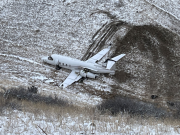The U.K. Air Accidents Investigation Branch (AAIB) has chastised an aircraft commander, the aircraft operator and a tour group operator for failing to promptly report to the AAIB a July 21 event in which a Boeing 737 operating with a lower-than-required thrust setting struck a runway approach light during takeoff from Belfast (Northern Ireland) International Airport.
“In slightly different circumstances, this event could have resulted in the loss of the aircraft with multiple fatalities,” the AAIB said in Special Bulletin S2/2017, issued earlier this week. “The seriousness of the potential outcome, and the lack of barriers remaining to prevent it had the event escalated, persuaded the AAIB that this was a significant event requiring an in-depth investigation.”
None of the 185 passengers and crew was injured, and the only damage was to the light, the AAIB bulletin said. The aircraft operator — not named in the bulletin — reported the event to the Transportation Safety Board of Canada, and air traffic controllers filed a mandatory occurrence report and submitted information to the NATS Aeronautical Fixed Telecommunications Network.
The AAIB saw the NATS information three days after the event and subsequently began its investigation. Because of the delay, recorded data, including data from the flight data recorder and cockpit voice recorder, were unavailable to investigators.
“This has been detrimental to the investigation and may hinder the identification of all the safety issues,” the AAIB said. “It was considered necessary, therefore, to use this special bulletin to highlight reporting obligations within the U.K. for accidents and serious incidents.”
The AAIB bulletin said the 737’s flight management computer (FMC) showed an N1 of 81.5 percent was used for takeoff rather than the required setting of 93.3 percent, which was “calculated by the operator and shown on the preflight paperwork.” As a result, the thrust setting was significantly lower than required, the AAIB said.
The AAIB added that “the only credible way to achieve a grossly low N1 setting was to enter an extremely low value into the outside air temperature (OAT) field” during FMC programming.
Updated software would have identified a data entry error, the AAIB said, but the software had not been installed in the airplane.
As a result of its preliminary investigation, the AAIB issued two safety recommendations calling on the U.S. Federal Aviation Administration to require use of the updated software in 737 Next Generation airplanes and calling on Boeing to ensure that all 737 operators are aware of the information contained in the special bulletin.



